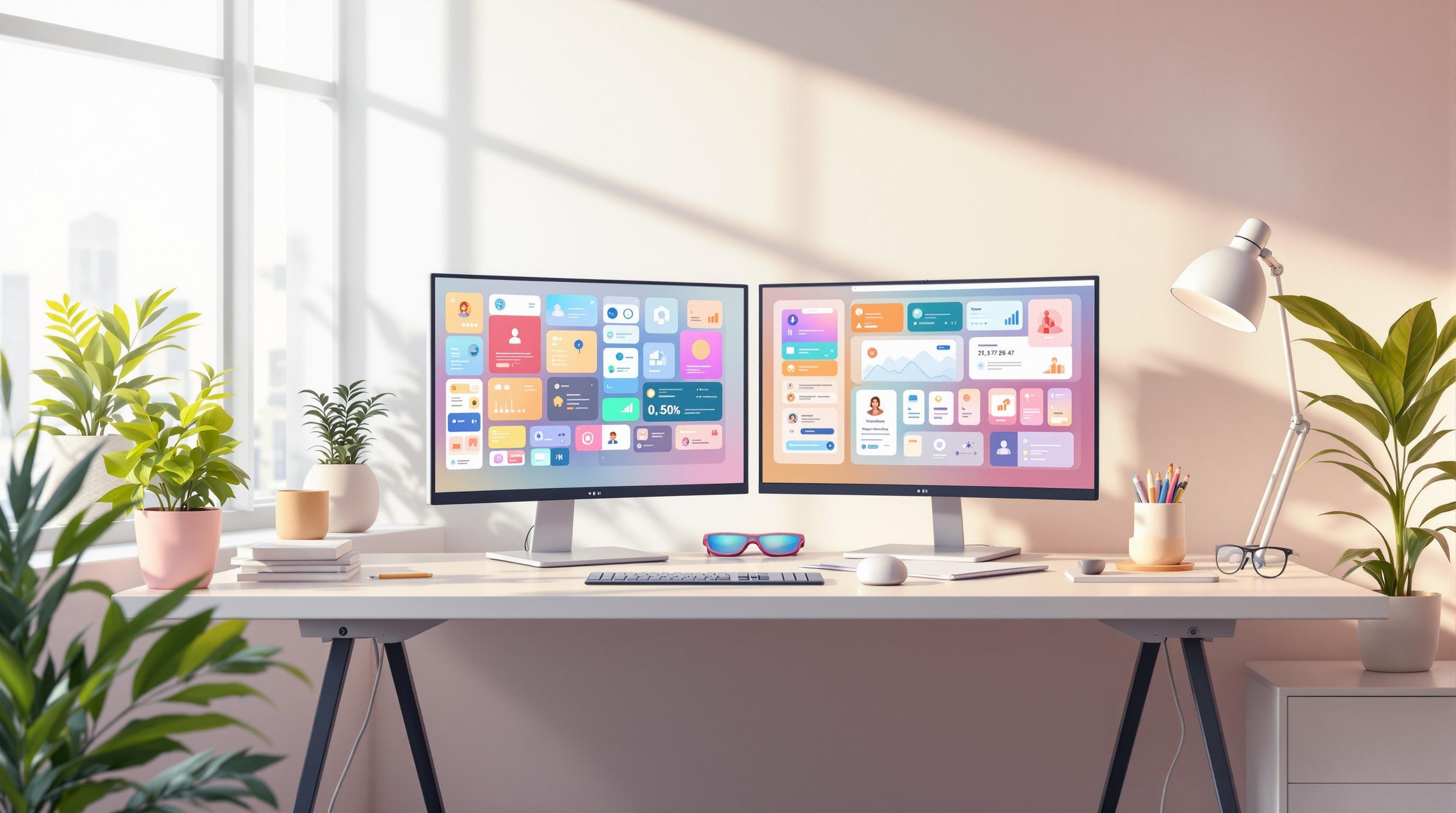UI/UX design trends this year focus on personalization, immersion, and user-centered innovation. Here are the 8 trends transforming how users interact with digital platforms:
- AI Personalization: Real-time adjustments based on user behavior for tailored experiences.
- 3D Object Interaction: Engaging, hands-on digital interactions inspired by real-world actions.
- Voice Interaction: Hands-free, natural voice commands powered by AI.
- Bento Box Layouts: Organized, compartmentalized interfaces for easier navigation.
- Proactive UX Design: Predicting user needs to simplify interactions.
- Ambient Customization: Real-time interface adjustments for seamless user experiences.
- Silent Login: Password-free authentication using biometrics and smart systems.
- Spatial Layout: Adding depth and dimension to digital interfaces for intuitive navigation.
Quick Comparison Table
| Trend | Key Feature | User Impact | Business Benefit |
|---|---|---|---|
| AI Personalization | Tailored recommendations | Personalized experiences | Increased engagement and retention |
| 3D Interaction | Real-world-like interactions | Immersive and engaging | Better user satisfaction |
| Voice Interaction | Natural voice commands | Hands-free convenience | Accessibility and differentiation |
| Bento Box Layout | Clear, compartmentalized content | Easy navigation | Simplifies MVP design |
| Proactive UX | Predictive features | Anticipates user needs | Streamlines user journeys |
| Ambient Customization | Real-time interface adaptation | Effortless interactions | Higher satisfaction and loyalty |
| Silent Login | Password-free authentication | Faster, smoother access | Reduced login abandonment |
| Spatial Layout | Depth-based navigation | Intuitive exploration | Improved engagement and comprehension |
Key takeaway: Start with simple implementations like AI personalization or Bento Box layouts for MVPs. Gradually expand into advanced features like spatial layouts or ambient customization as your product evolves. These trends aren’t just about aesthetics – they’re about solving user problems efficiently.
UX/UI Design Trends 2025
1. AI Personalization
AI personalization is changing the way we interact online in 2025, offering custom experiences by analyzing user behavior in real-time. These systems learn from how users interact, adjusting interfaces and recommendations to match preferences. A good example is Instagram’s algorithm, which tailors feeds based on user engagement and allows users to fine-tune recommendations with "interested" and "not interested" options [5].
For startups working on MVPs, integrating AI personalization doesn’t have to be complicated:
- Monitor user behavior and interactions.
- Add features that adjust to personal preferences.
- Provide tools like toggles for users to share feedback.
Starting with personalization in MVPs helps build user loyalty and collect valuable data for future updates. This approach can directly impact key performance metrics:
| Feature | User Benefit | Business Impact |
|---|---|---|
| Dynamic Interface Adaptation | Personalized layouts based on usage patterns | Boosts engagement rates |
| Predictive Content | Shows relevant recommendations proactively | Increases time spent in-app |
| Smart Navigation | Easier access to frequently used features | Lowers bounce rates |
| Behavioral Analysis | Creates tailored user journeys | Improves conversion rates |
Privacy and Trust
Being transparent and following privacy regulations is critical when using AI personalization. Letting users control their settings not only builds trust but also ensures they feel comfortable with the tailored experience.
Accessibility Improvements
AI personalization also makes digital experiences more accessible. Voice interfaces and adaptive layouts can adjust to meet a variety of user needs [2].
While AI personalization focuses on refining individual interactions, advancements like 3D object interaction are also reshaping how users physically connect with digital platforms.
2. 3D Object Interaction
By 2025, 3D object interaction has shifted from being just a cool feature to becoming a practical part of UI/UX design. It allows users to interact with digital content in ways that feel more natural, mimicking real-world actions. While AI fine-tunes user preferences, 3D interaction adds a layer of engagement by offering hands-on, immersive experiences.
These 3D elements now serve more than just visual appeal. Take IKEA’s Place app, for example – it lets customers see how furniture fits into their actual rooms before buying. This not only reduces returns but also improves customer satisfaction [3].
When adding 3D objects to modern interfaces, there are several factors to keep in mind:
| Aspect | Consideration | Impact |
|---|---|---|
| Performance | Processing power | Influences load times and user experience |
| Navigation | Intuitive control mechanisms | Determines ease of use |
| Accessibility | User comfort and safety | Encourages broader adoption |
| Integration | UI integration | Ensures smooth interaction |
For startups creating MVPs, keep it simple at first. For example, implement basic object rotation to minimize processing demands. As user interest grows, you can gradually add more features. Techniques like lazy loading can also help optimize 3D assets for faster performance, keeping things efficient without sacrificing quality.
Always prioritize user comfort and accessibility. Make sure essential features remain usable via 2D interfaces for those who may not prefer or need 3D interaction [3].
While 3D object interaction boosts visual engagement, voice interaction is simultaneously transforming how users interact with technology.
3. Voice Interaction
Voice interaction has become a central part of UI/UX design in 2025. Building on the rise of 3D interactions, voice interfaces offer a natural and easy way for users to interact with digital products.
Thanks to advancements in AI and natural language processing, voice recognition is now highly accurate, making it a practical option for primary interactions. For startups, voice interaction provides an affordable way to stand out by addressing accessibility needs and enabling hands-free usage.
| Implementation Aspect | Key Consideration | Impact on UX |
|---|---|---|
| Command Design | Use clear phrases and offer fallback options | Minimizes friction and supports accessibility |
| Context Awareness | Deliver responses suited to specific situations | Improves the overall user experience |
| Performance | Focus on speed and accuracy | Encourages user adoption |
When adding voice interactions, startups should prioritize specific, high-value use cases rather than trying to make everything voice-controlled. For example, voice commands are ideal for hands-free tasks like cooking or driving but might feel unnecessary for simpler actions better handled by traditional interfaces.
"Voice interfaces are a leading 2025 UI/UX trend" [4]
To create effective voice interactions, consider these key practices:
- Offer clear feedback when a command is understood or not.
- Keep traditional interface options available alongside voice controls.
- Design conversational flows instead of rigid, single-command structures.
These strategies have shown success in areas like smart home devices and mobile banking, where voice commands simplify everyday tasks.
To ensure ongoing improvement, monitor how often users successfully complete tasks using voice commands. This data can help refine recognition accuracy and improve command design, keeping the interface aligned with user needs.
While voice interaction opens doors for accessibility and convenience, the next trend dives into organizing visual content effectively: Bento Box Layouts.
4. Bento Box Layout
The Bento Box layout, inspired by Japanese meal containers, breaks down digital interfaces into clear, easy-to-navigate sections. With 38% of users leaving websites due to cluttered designs, this layout helps keep visitors engaged by reducing confusion and improving usability [4]. It emphasizes structured content, making it easier for users to process information.
By dividing content into distinct compartments, this design approach creates a clear hierarchy, helping users find what they need with less effort. Startups often find it especially useful for MVPs (Minimum Viable Products) because it simplifies complex features, making early-stage products more user-friendly.
| Design Element | Purpose | Impact on User Experience |
|---|---|---|
| Compartmentalization | Groups related content | Makes navigation easier |
| Visual Hierarchy | Directs user attention | Enhances navigation flow |
| Whitespace Balance | Adds breathing room | Improves focus and readability |
To use this layout effectively, prioritize clean typography, balanced spacing, and highlight key content. It’s a great fit for content-heavy platforms and dashboards, where clarity is essential.
Bento Box layouts also work well with AI-driven personalization, organizing tailored content into well-defined sections. This approach ensures users can quickly access relevant information, improving their overall experience.
For startups adopting this design, regular user testing is key. Keep the layout simple and ensure every section provides real value. This method not only organizes content but also aligns with Proactive UX Design principles, anticipating user needs and delivering solutions effortlessly.
sbb-itb-51b9a02
5. Proactive UX Design
Proactive UX Design goes beyond reacting to user actions – it predicts what users need, turning digital interactions into seamless, personalized experiences. Unlike AI Personalization, which adjusts based on user preferences, Proactive UX focuses on anticipating needs to simplify interactions. This approach is expected to shape more responsive digital products by 2025.
| Component | Traditional UX | Proactive UX |
|---|---|---|
| User Interaction | Reacts to user actions | Anticipates user needs |
| Interface Evolution | Manual updates | Continuous AI-powered learning |
For startups developing MVPs, adopting Proactive UX Design requires careful planning. Start small by focusing on one predictive feature, like context-aware navigation, to create an impactful design without overextending resources. Prioritize features that offer the most value through anticipatory design.
- Smart Navigation and Adaptive Interfaces: Proactive systems analyze user behavior and context to make tasks easier. For example, Netflix fine-tunes content recommendations in real time, making navigation faster and more relevant. These features enhance user experiences while keeping the design straightforward.
When implementing Proactive UX, transparency and user control are essential. Users need to understand how and why interfaces change based on their behavior. This builds trust and ensures the technology serves their needs effectively.
For startups, the best approach is to start small and scale gradually. Introduce one or two proactive features, assess their impact, and expand based on feedback. This strategy helps manage resources efficiently while staying focused on delivering meaningful improvements.
Proactive UX Design also works well alongside trends like AI Personalization and Bento Box layouts, creating a unified and intuitive user experience. The aim is to reduce mental effort for users while increasing engagement through predictive design.
While Proactive UX Design enhances interactions by anticipating needs, Ambient Customization takes it further by adjusting environments in real time to match user preferences.
6. Ambient Customization
Ambient customization goes a step beyond Proactive UX Design by shaping environments in real time. It creates interfaces that adjust fluidly to user interactions and context, offering a smoother experience compared to older personalization methods.
| Feature | Traditional Personalization | Ambient Customization |
|---|---|---|
| Data Processing | Delayed batch updates | Real-time adaptation |
| User Control | User-set preferences | Automatic adjustments |
| Context Awareness | Limited to profile data | Real-time behavioral insights |
According to McKinsey, this approach can increase customer satisfaction by 20-30% and reduce churn by 10-30% [1][2]. A great example is Spotify, which tailors playlists, themes, and navigation on the fly based on how users engage with the app. This makes the experience feel effortless and intuitive.
For startups, ambient customization can set an MVP apart by creating adaptive experiences that feel natural, even with fewer features. To make it work, consider these steps:
- Start with Key Features: Focus on areas where real-time customization will have the biggest impact. Tools like Adobe Target or Google Analytics can help analyze user behavior and implement basic changes efficiently.
- Emphasize Privacy: Be transparent about how data is collected and used, and let users manage their personalization settings to build trust.
7. Silent Login
Silent login removes the need for passwords, offering a quick and effortless way for users to verify their identity. By cutting out the usual authentication hurdles, it’s changing how people interact with digital platforms.
| Aspect | Traditional Login | Silent Login |
|---|---|---|
| Ease of Use | Manual entry, 15-30 seconds | Automatic, near-instant |
| Security Level | Relies on passwords | Biometric and multi-factor |
| User Experience | Can feel cumbersome | Smooth and integrated |
Take Google’s Smart Lock, for instance. It has lowered login abandonment rates by 35% across Android apps. This highlights how silent login not only makes things easier for users but also keeps security intact. For startups building MVPs, it simplifies development while improving user satisfaction – a win-win.
Here’s how to get started with silent login:
- Smart Authentication Setup: Use device recognition and native biometric APIs. This method is quick to deploy and cost-effective. Companies like Auth0 have seen a 60% drop in login friction using this approach.
- Behavioral Monitoring: Implement AI to track user behavior patterns. This strengthens security and reduces fraud. IBM Security Verify has shown a 73% decrease in fraudulent access attempts when compared to older systems.
To measure success, track metrics like login success rates, session lengths, and user retention. Businesses adopting silent login have reported an 88% drop in support tickets related to authentication issues and a 94% improvement in first-time login success rates [4].
That said, maintaining user trust is key. Always provide alternative login options for those who prefer traditional methods. This balance ensures innovation doesn’t come at the cost of user confidence.
While silent login improves security and ease of use, the next trend aims to reshape how users explore and interact with digital environments.
8. Spatial Layout
Spatial layout moves beyond flat, 2D interfaces to create immersive, three-dimensional experiences. This approach adds depth and dimension to digital spaces, making interactions feel more natural and fluid.
| Design Element | Traditional Layout | Spatial Layout |
|---|---|---|
| User Navigation | Linear menus | Space-based navigation |
| Content Organization | Flat hierarchies | Depth-based hierarchies |
| Interaction Model | Click and scroll | Multi-dimensional movement |
| Visual Depth | Limited to 2D planes | Rich 3D environments |
For startups working on MVPs, you don’t need to dive into complex VR setups to incorporate spatial design. Here are some practical ways to get started:
- Start Small with 3D Elements: Pinterest introduced subtle depth indicators that made content discovery easier, leading to a 28% boost in engagement.
- Prioritize Performance: Ensure users can navigate depth-based interfaces smoothly, regardless of device or screen size. Address challenges like depth perception and provide clear navigation cues.
- Keep Accessibility in Mind: Offer alternative navigation options for users who may struggle with spatial interfaces, and ensure compatibility across platforms.
Spatial interfaces are proven to engage users more effectively. Studies show users spend 27% more time interacting with these layouts, thanks to their intuitive hierarchies [3]. By using depth to organize content, spatial designs improve both engagement and comprehension.
In data visualization, spatial layouts offer distinct advantages. Plaid, for instance, used spatial design in its transaction analysis tools, improving financial data comprehension by 40%. When paired with thoughtful UX, spatial layouts can predict user behavior and create environments that feel seamless and engaging.
The secret to successful spatial design is creating environments that simplify rather than complicate interactions. By putting users first, spatial layouts are reshaping how we experience digital interfaces.
Conclusion
The eight trends discussed highlight a move toward more intuitive, personalized, and immersive digital designs. From AI-powered customization to spatial layouts, each trend offers startups a chance to craft engaging and impactful digital experiences.
| Trend Impact Areas | Key Advantages | Implementation Focus |
|---|---|---|
| User Experience | Personalization and accessibility | High Priority |
| Market Position | Differentiation from competitors | Essential |
| Development | Faster iteration and scalability | Moderate |
| User Retention | Boosted engagement and loyalty | Top Priority |
To successfully integrate these trends into your MVP, aim for a balanced strategy. Start with AI-driven personalization and user-focused design as the foundation, then gradually incorporate advanced features as your product matures.
These trends go beyond aesthetics – they’re about creating interactions that address real user challenges efficiently. For startups working within tight budgets and timelines, prioritize features that provide the most value while ensuring future scalability. Aligning these trends with your product goals will help your MVP meet user expectations and stand out in a competitive market.
The evolution of UI/UX design emphasizes personalization, user-first thinking, and leveraging emerging technologies. For startups, this means focusing on trends that resonate with user needs and business goals. Every design choice should enhance your MVP’s ability to deliver a seamless and impactful user experience, setting the stage for long-term success.









Leave a Reply